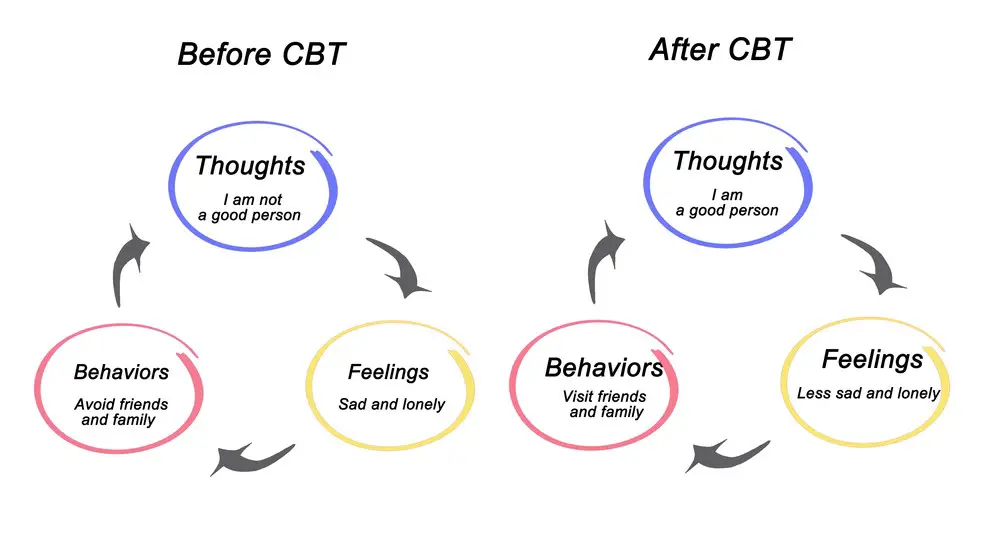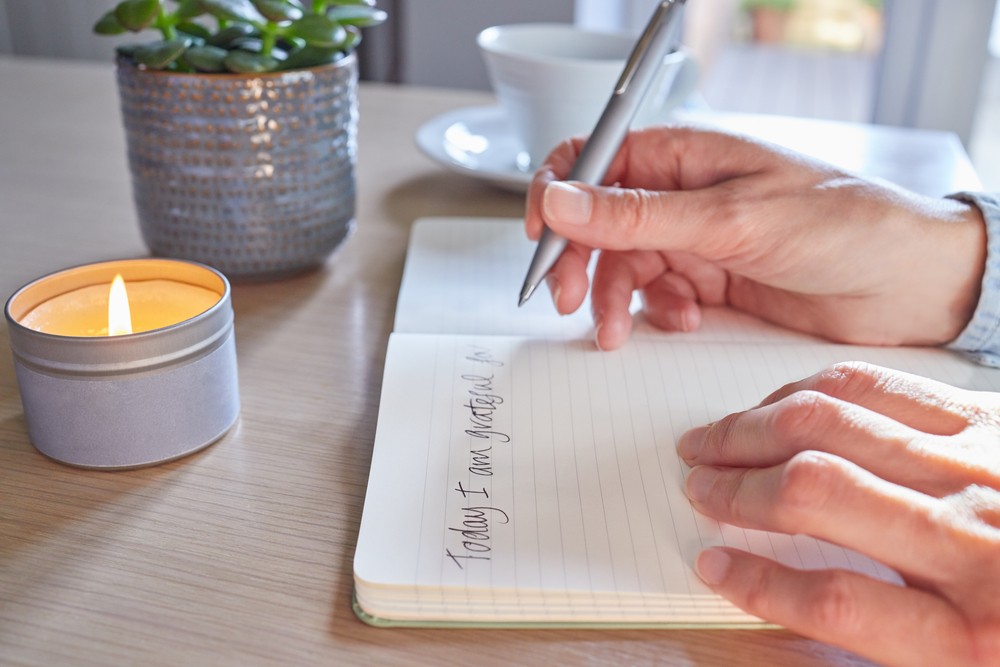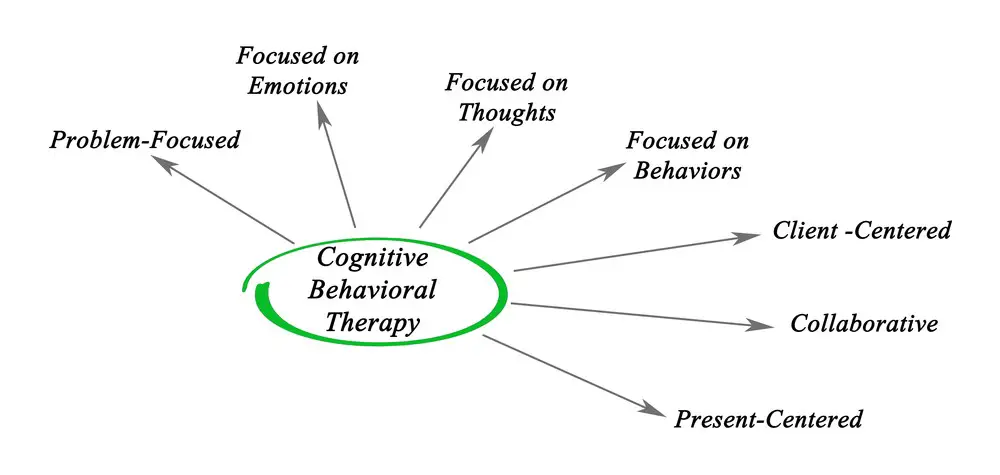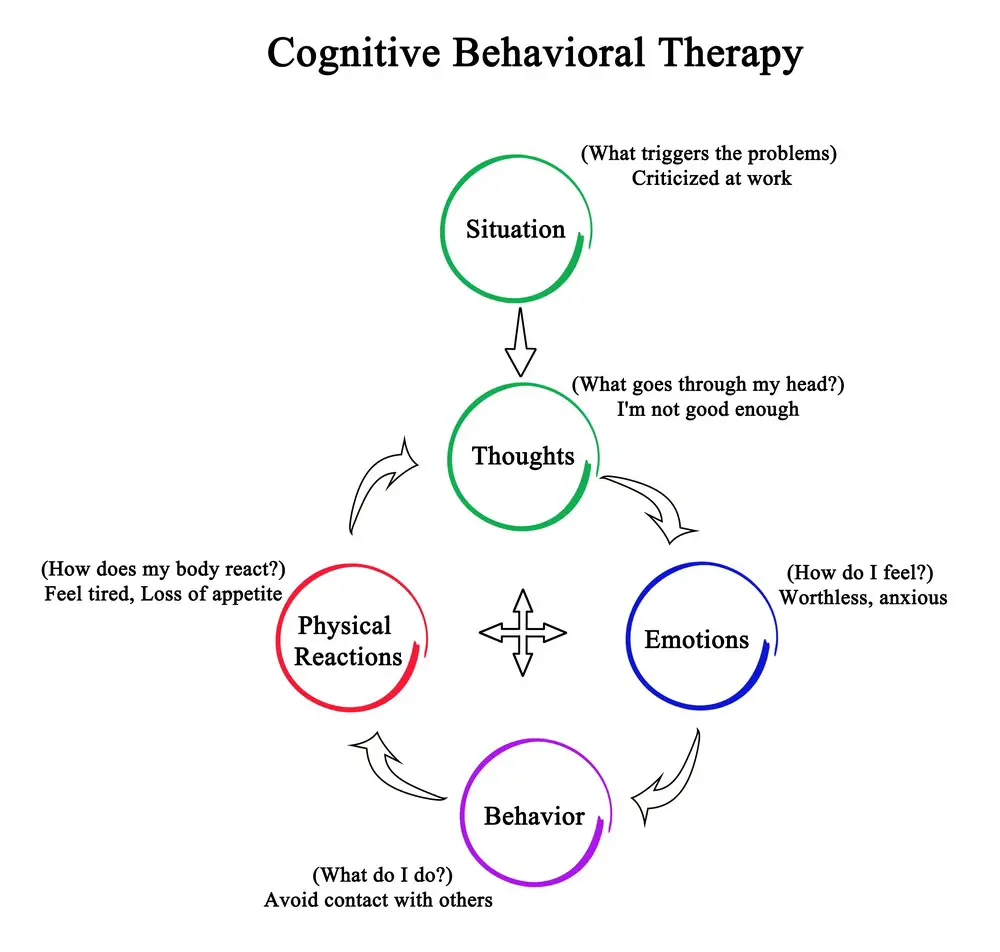As a BetterHelp affiliate, we receive compensation from BetterHelp if you purchase products or services through the links provided
Cognitive Behavioral Therapy (CBT) journal prompts are an effective way to delve into one’s thoughts and emotions, ultimately fostering self-awareness and personal growth. By using CBT techniques in journaling, individuals can identify patterns in their thinking and behavior, helping them recognize and change negative thought patterns. A key advantage of CBT journaling is that it can be easily implemented daily, making it an accessible tool for improved mental health and emotional well-being.
The process of CBT journaling involves exploring emotions, thoughts, and reactions to various situations while incorporating mindfulness and gratitude practices to understand better the connection between thoughts, feelings, and actions. As individuals become more adept at identifying and addressing their thought patterns, they can apply these skills to various aspects of their lives, ultimately leading to more balanced and fulfilling experiences. It’s also important to note that seeking professional help and support can further enhance the benefits of CBT journaling.
Key Takeaways
- CBT journal prompts assist in identifying and changing negative thought patterns.
- Incorporating mindfulness and gratitude practices deepens self-awareness and emotional well-being.
- Applying CBT journaling skills to various life areas leads to more balanced experiences.
Understanding CBT Journaling
Cognitive Behavioral Therapy
Cognitive Behavioral Therapy (CBT) is a widely-used therapeutic approach that helps people identify and change negative thought patterns and behaviors. It emphasizes the connection between thoughts, feelings, and actions, focusing on how thoughts influence emotions and, in turn, behavior. By recognizing these patterns, individuals can modify their reactions and develop healthier coping strategies.
CBT journaling is a tool within this therapy that encourages individuals to reflect on their thoughts and emotions through writing. It incorporates journal prompts, questions, or exercises designed to guide individuals through exploring and addressing their mental health concerns.
Benefits for Mental Health
CBT journaling can provide several benefits for mental health, such as:
- Self-awareness: Regular journaling can help individuals gain insight into their thought patterns, allowing them to recognize triggers and identify areas where change is needed.
- Coping skills: Writing about emotions and experiences can help people process and manage overwhelming feelings, promoting healthier coping strategies.
- Reduced stress: Often, getting thoughts and feelings out of one’s head and onto paper can decrease stress and anxiety levels.
- Problem-solving: Journaling provides a safe space for individuals to explore different perspectives and potential solutions to problems they may be facing.
- Treatment collaboration: therapists can customize CBT journal prompts to facilitate a better understanding of their client’s thoughts and experiences, helping to tailor treatment plans. The client’s self-reflection promotes an active role in their mental health journey.
Incorporating CBT journaling into one’s mental health routine can foster personal growth and improve overall well-being. Writing down thoughts, emotions, and experiences, guided by tailored journal prompts, allows individuals to confront their issues effectively and develop healthier perspectives and coping skills.
Getting Started with CBT Journal Prompts
Cognitive Behavioral Therapy (CBT) journal prompts can be effective for self-reflection and self-improvement. To embark on this journey, you must select the right materials and establish a journaling habit.
Choosing a Notebook and Pen
The first step is to choose a suitable notebook and pen for journaling. When selecting a notebook, consider the following:
- Size: A notebook that is too small might be uncomfortable for writing, while one that is too large may be cumbersome.
- Paper quality: A higher-quality journal will be more pleasant to write on and last longer.
- Binding: A sturdy binding ensures the journal will withstand daily wear and tear.
- Design: Choose a design that speaks to you and inspires you to write.
Similarly, selecting a pen that suits your writing style and preferences will contribute to a smoother journaling experience. Factors to consider include:
- Ink type: Ballpoint, rollerball, or gel pens come in various ink types; choose one that feels smooth and flows well.
- Tip size: A tip size suitable for your handwriting will enhance legibility.
- Grip: A comfortable grip reduces strain during writing sessions.
Developing a Journaling Habit
Creating a consistent journaling habit allows you to derive the most benefits from CBT journal prompts. Consider the following tips:
- Set a regular time: Choose a specific time each day to journal, whether in the morning, evening or during lunch breaks.
- Choose a comfortable location: Find a quiet space to relax and focus on your journaling without distractions.
- Start small and build up: Begin with a few minutes each day, gradually increasing the duration as you become more comfortable with the process.
- Incorporate journal prompts: Utilize CBT journal prompts that address area where you’d like to improve or explore deeper thoughts and emotions.
- Track your progress: Reviewing past entries will allow you to gauge your development and adjust your journal prompts accordingly.
Following these guidelines will prepare you to start your journey with CBT journal prompts and experience their benefits.
Exploring Emotions and Thoughts

Anxiety and Depression
Cognitive Behavioral Therapy (CBT) journal prompts can help individuals explore their emotions and thoughts, leading to a better understanding of their mental health. For those experiencing anxiety and depression, consider the following journal prompts:
- Identify triggers: List situations or events that often cause anxiety or depressive thoughts.
- Thought patterns: Reflect on thoughts during anxious or depressive moments.
- Coping mechanisms: Write about the methods you use to help manage anxiety and depression.
Anger and Frustration
It is not uncommon for individuals to experience anger and frustration. Using CBT journal prompts, one can explore various aspects of these emotions:
- Recognize patterns: Note instances or circumstances frequently leading to anger and frustration.
- Underlying emotions: Consider the possible underlying emotions contributing to anger and frustration.
- Constructive responses: Think about healthy ways to express and manage these emotions.
Happiness and Joy
Focusing on positive emotions, such as happiness and joy, can help improve overall mental well-being. Utilize CBT journal prompts to delve further into these feelings:
- Gratitude: List the things, people, or experiences you are grateful for.
- Emotional drivers: Identify the factors contributing to your happiness and joy.
- Self-care: Reflect on the activities you enjoy that contribute to your overall emotional well-being.
CBT Techniques for Journaling

Identifying Unhelpful Thought Patterns
Cognitive Behavioral Therapy (CBT) is an effective psychological tool to address negative thoughts and behaviors. Through journaling, individuals can identify unhelpful thought patterns such as catastrophizing or black-and-white thinking. By recognizing these patterns, individuals can begin to challenge and change them.
For example, one may write about a stressful event and list out negative thoughts associated with it. Then, they can reflect on whether these thoughts are accurate or distorted, helping them understand their thought process.
Cognitive Restructuring
Cognitive restructuring involves changing unhelpful thought patterns into more accurate and helpful perspectives. Journaling provides a structured opportunity for individuals to break down their thoughts and examine them objectively.
By writing down distorted thoughts, individuals can highlight irrational beliefs, consider alternative viewpoints, or gather evidence that challenges these beliefs. This process helps develop positive thoughts, leading to healthier and more balanced perspectives.
Coping Strategies
Developing coping strategies is an essential component of CBT. Journaling encourages individuals to explore different approaches for managing stress and negative emotions. These techniques may include deep breathing exercises, physical activity, or seeking support from friends and family.
In the journal, people can outline situations that trigger negative thoughts and list various coping strategies that have proven effective. Over time, identifying the best strategies helps create a personalized toolbox for managing emotions.
Stress Management
CBT journaling fosters better stress management through self-reflection and identifying triggers. As individuals write about stressful events, they gain insight into factors contributing to increased stress levels. By understanding these triggers, they can develop strategies to minimize or avoid them.
Additionally, journaling promotes mindfulness and relaxation, helping individuals develop healthy habits to manage their stress. People learn to confront their thoughts and feelings throughout the process, fostering a more balanced emotional state.

Incorporating Mindfulness and Gratitude
Meditation and Relaxation
Mindfulness and gratitude can be incorporated into one’s daily routine through meditation and relaxation techniques. Practicing meditation enables individuals to quiet their minds and develop greater awareness. They become more attuned to their thoughts, feelings, and surroundings. Some popular meditation techniques include:
- Focused meditation: Concentrating on a specific object, such as a candle flame or sound.
- Mindfulness meditation: Paying attention to your thoughts and feelings without judgment.
- Body scan meditation: Gradually moving your focus through different parts of the body to release tension and achieve relaxation.
Regular relaxation practices promote mindfulness and gratitude by helping individuals reduce stress and anxiety. This creates a calm mental state, allowing the mind to reflect on positive experiences and find gratitude for the present moment. Techniques to achieve relaxation include:
- Deep breathing: Taking slow, deep breaths to activate the body’s natural relaxation response.
- Progressive muscle relaxation: Tensing and relaxing different muscle groups to release physical tension.
Appreciating the Present Moment
Cultivating mindfulness and gratitude involves appreciating the present moment. This can be achieved by focusing on the senses, including taste, touch, smell, sound, and sight. By truly experiencing the present moment, individuals become more aware of their surroundings and can better appreciate the positive aspects of their lives.
One way to practice appreciating the present moment is through journaling. This activity encourages reflection on daily experiences and promotes a focused, mindful approach to life. Journal prompts that foster mindfulness and gratitude may include:
- List three things you are grateful for today.
- Write a description of a sensory experience you had in full detail.
- Reflect on a meaningful interaction or conversation you had with someone.
Incorporating mindfulness and gratitude practices, like meditation, relaxation, and journaling, can profoundly impact an individual’s overall well-being and mental health. These practices foster a deeper awareness of the present moment, allowing one to recognize and appreciate the positive aspects of life.

Applying CBT Journaling to Life Areas
Work and Career
CBT journal prompts can address various aspects of work and career. By reflecting on goals, a person can identify areas for growth and create an action plan for achieving them. For example, they may list their short-term and long-term career goals, then explore potential actions and steps to reach them.
Another way to apply CBT journaling to work and career is by analyzing fears surrounding job performance or job loss. Journaling about the origin of these fears, their rationality, and ways to overcome them can support an individual in building self-esteem and confidence in their abilities.
Relationships
In relationships, CBT journaling can help address communication challenges, identify patterns, and improve understanding between partners. For instance, one might journal about specific situations that led to misunderstandings or disagreements and analyze the underlying thoughts and emotions. From there, they can explore alternative perspectives or consider ways to communicate more effectively in the future.
CBT journal prompts can also be applied to examining personal relationships with family members and friends. Identifying patterns and themes within these interactions, and considering the role of one’s beliefs and values, can lead to insights and create opportunities for positive change.
Personal Values
Finally, CBT journal prompts can help individuals clarify and solidify their values. They might reflect on the values they hold dear and how they influence their choices and behaviors. Through journaling, individuals can recognize discrepancies between their values and actions, better aligning their decisions with those values moving forward. With a clear understanding of personal values, one can make more informed choices and maintain a sense of authenticity.

Professional Help and Support
Finding a Trained Practitioner
Finding a trained practitioner, such as a counselor or clinical psychologist, is crucial when seeking professional help with cognitive-behavioral therapy (CBT). These practitioners have the necessary expertise and experience to effectively guide individuals through the process. Choosing a qualified professional ensures that the most suitable problems and solutions are addressed during therapy sessions.
One can find a reputable practitioner by researching online directories, requesting recommendations from friends and family, or consulting with their primary healthcare provider. It is essential to verify the practitioner’s credentials, such as their degree and licensing, to ensure they are qualified to provide CBT services.
Combining CBT Journaling with Therapy
CBT journaling, also known as expressive writing, can be a powerful complement to traditional therapy sessions. This approach allows individuals to process their thoughts and emotions in a structured manner, promoting self-awareness and the development of healthy coping strategies.
When combining CBT journaling with therapy, the therapist may provide specific prompts or exercises for the individual to complete in their journal. These prompts are tailored to the person’s unique needs, helping to address specific issues and concerns. In addition, the therapist may review the journal entries during therapy sessions to gain insight into the individual’s progress and provide further guidance.
By integrating expressive writing with sessions led by a trained practitioner, individuals can maximize the benefits of cognitive-behavioral therapy. Combining these methodologies helps create a more comprehensive approach to tackling problems and developing long-lasting solutions for mental well-being.
Frequently Asked Questions
What are CBT journal prompts?
CBT journal prompts are an effective way to delve into one’s thoughts and emotions, ultimately fostering self-awareness and personal growth. By using CBT techniques in journaling, individuals can identify patterns in their thinking and behavior, helping them recognize and change negative thought patterns.
What are the advantages of using CBT journaling?
A key advantage of CBT journaling is that it can be easily implemented daily, making it an accessible tool for improved mental health and emotional well-being. Additionally, by exploring emotions, thoughts, and reactions to various situations while incorporating mindfulness and gratitude practices into the process, individuals can develop more balanced and fulfilling experiences.
What are some common thought patterns to challenge?
Common thought patterns to challenge include all-or-nothing thinking, overgeneralization, mental filtering, and personalization. Individuals can develop better mental health habits by identifying and reframing these thoughts into more positive and realistic ones.
What are cognitive distortions?
Cognitive distortions are irrational or exaggerated thought patterns that can lead to negative emotions and behaviors. Examples of cognitive distortions include catastrophizing, emotional reasoning, and magnification/minimization. Identifying cognitive distortions involves becoming aware of one’s thoughts and analyzing whether they are based on facts or distortions.
How can I become more aware of my emotions?
Emotions and bodily sensations are closely connected. An individual can become more aware of their emotions by paying attention to the physical sensations that accompany them. For example, they may notice that anxiety causes an increased heart rate, while anger might create tension in their shoulders.
What are some common anxiety triggers?
Common anxiety triggers include social situations, health concerns, or changes in routine. Awareness of these triggers is essential for managing anxiety and developing effective coping strategies.
How can I develop coping strategies for managing my emotions?
Effective coping strategies include deep breathing exercises, mindfulness techniques, and progressive muscle relaxation. Incorporating these into daily routines can help to reduce anxiety and stress levels, improving overall well-being.
What is involved in gratitude reflections?
Gratitude reflections involve acknowledging and appreciating the positive aspects of one’s life. This can be done by journaling about positive experiences, writing gratitude letters, or simply reflecting on things to be grateful for each day. Incorporating gratitude reflections into daily routines can help shift mindset and promote overall mental health.
What are the benefits of using CBT journaling?
The primary benefit of using CBT journaling is improved mental health and emotional well-being. Journaling helps to identify cognitive distortions, challenge negative thought patterns, become more aware of emotions and bodily sensations, recognize anxiety triggers, develop coping strategies, and practice gratitude reflections. By regularly investing time into this self-reflection process, individuals can strengthen their mental resilience and foster healthier habits for better overall well-being.
How can I incorporate CBT journaling into my everyday life?
The key to successful CBT journaling is consistency and commitment. To make it part of your daily routine, set aside a specific time each day for self-reflection. This does not have to be long — even 10 minutes can be beneficial. Use this devoted time to record thoughts, emotions, and reactions that occurred throughout the day to gain deeper insight into yourself and find ways to improve your mental health. Additionally, consider finding an accountability partner or joining an online group for further support as you work through the process.
- Breaking the Silence: Why Men’s Mental Health Matters More Than Ever - April 15, 2025
- How to Transform a Home’s Patio Space into a Relaxing Space - March 23, 2025
- 5 Strategies to Use a Cell Phone to Help Manage Your Stress - March 23, 2025
This site contains affiliate links to products. We will receive a commission for purchases made through these links.



